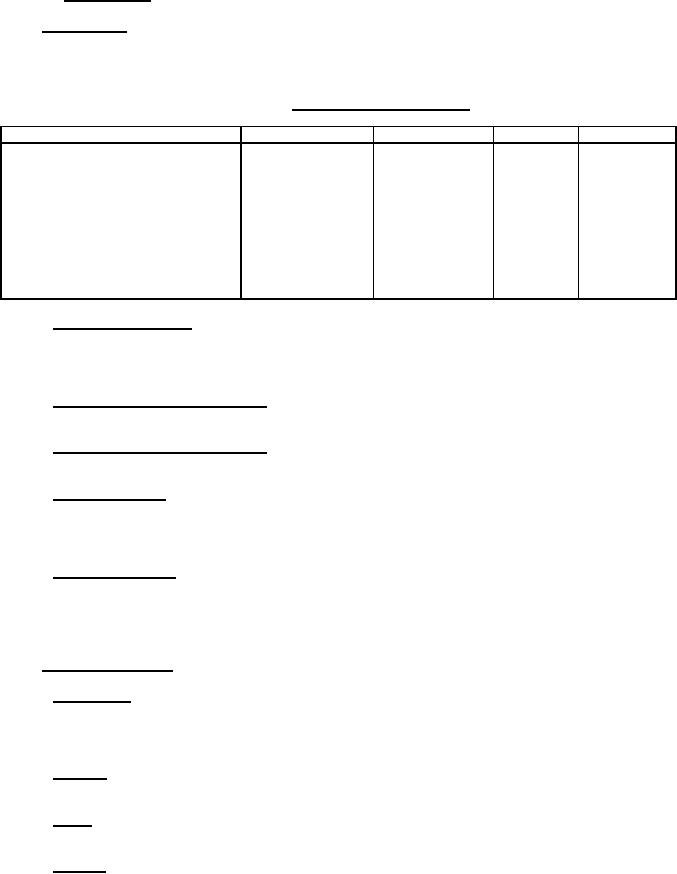
MIL-DTL-27467B
4.4.2.4 Sampling plan. Accept on zero, for general inspection as specified in table II.
4.5 Test schedule. The headsets shall be subjected to the tests listed in table II in the quantities shown. The
order of performing the first article or acceptance tests is immaterial except that the salt fog test shall be last. At the
end of each test, the headset shall be thoroughly inspected and checked for any damage, defects, or deterioration
resulting from the tests.
TABLE II. First article and conformance.
Inspection or test
Requirement
Test procedures
Individual
Sample
Examination of product
all
all
DC resistance of headset circuit
all
DC resistance of microphone circuit
all
Acoustic distortion
all
Functional operation
all
Temperature-altitude
all
Vibration
Shock
all
Humidity
1%
Salt fog
4.5.1 Examination of product. The headset shall be inspected thoroughly to determine conformance to the
requirements of this specification with respect to materials, mechanical detail, workmanship, physical dimensions,
and finishes, prior to and during assembly. Particular attention shall be paid to neatness and thoroughness of
soldering, wiring, marking of parts and assemblies, painting, and screw assemblies.
4.5.2 DC resistance of the headset circuit. The DC resistance of the headset circuit shall be measured across the
earphone contacts of Telephone Plug U-174/U (see 3.5.1.2).
4.5.3 DC resistance of microphone circuit. The DC resistance of the microphone circuit shall be measured with
the microphone contacts of telephone Plug U-174/U short circuited (see 3.5.1.3).
4.5.4 Acoustic Distortion. Electrical voice signals shall be applied across the earphone contacts of Telephone
Plug U-174/U. The input shall be such that the peak of the speech signal applied to the headset is at least 2.0 volts
rms. During this test, the operator shall listen for buzzes, rattles, or voice distortion in the acoustic output of the
headset (see 3.5.2.1).
4.5.5 Functional operation. A microphone, with impedance between 2.0 to 5.0 ohms, shall be connected to the
microphone circuit of the headset, as shown on figure 2. Telephone Plug U-174/U on the headset shall be inserted in
a Telephone Jack U-92A/U that has the earphone contacts connected to the output of an amplifier of suitable gain
and the microphone contacts to the input of the same amplifier. During this test, the talker shall listen to his own
voice while speaking into the microphone to insure that the headset is functioning satisfactorily.
4.6 Environmental testing.
4.6.1 Temperature. The headset or headset-microphone shall be tested in accordance with
MIL-STD-810, method 501, procedure 1 with a storage temperature of -55°C and an operating temperature of -40°C
and MIL-STD-810, method 502, procedure 1 with a storage temperature of 70°C and an operating temperature of
4.6.2 Vibration. The headset or headset-microphone shall be tested in accordance with test
4.6.3 Shock. The headset or headset-microphone shall be tested in accordance with test
method 213 of MIL-STD-202, test condition A. Upon completion of the test in 4.5.2 shall be performed (see 3.6.3).
4.6.4 Humidity. The headset or headset-microphone shall be tested in accordance with
method 103 of MIL-STD-202, test condition B. Upon completion of the test in 4.5.2 shall be performed (see 3.6.4).
6
For Parts Inquires call Parts Hangar, Inc (727) 493-0744
© Copyright 2015 Integrated Publishing, Inc.
A Service Disabled Veteran Owned Small Business